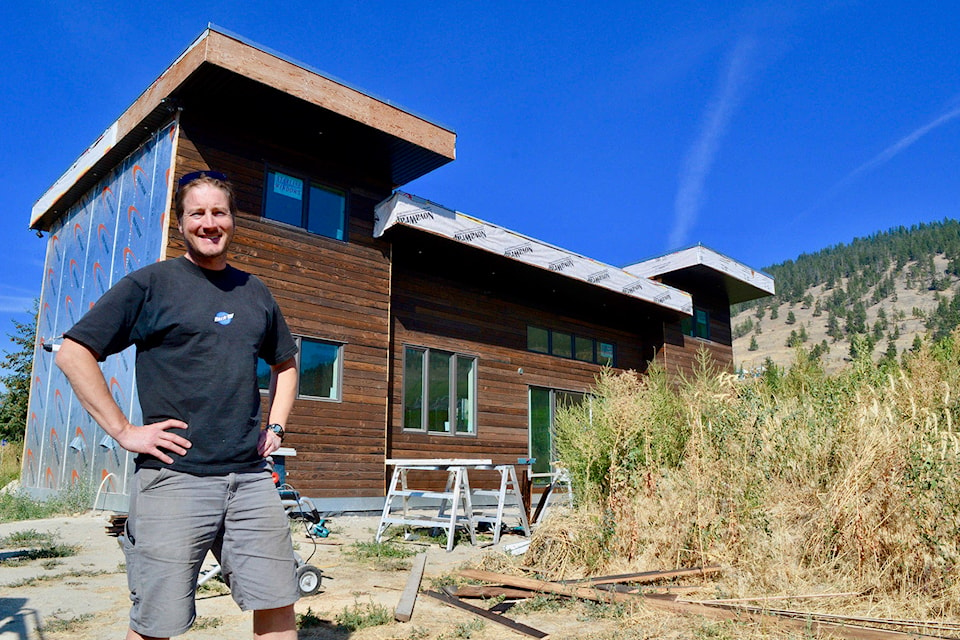Students at Okanagan College built on their skills by designing a sustainable home on an Upper Bench vineyard.
This year’s class in the Sustainable Construction Management Technology (SCMT) diploma designed a home for the Roche family.
“When we were looking around in the Okanagan, a lot of vineyards seemed to have a small amount of land for the vineyard, but large houses. We were looking for the opposite,” said Dylan Roche. “We liked the idea of building something affordable but comfortable, that was easy to heat and live in.”
Roche knew Brian Rippy, a professor in the SCMT department with 15 years of experience in sustainable design and construction management.
Rippy recommended the family’s home become a project for students, who are required to complete a real-world project and demonstrate the skills and knowledge gained in the program.
Students have two terms to work on the project. The first term is used to design a project that meets their client’s requirements, with the second term involving construction project management.
Through consultations with Rippy, Roche and his family designed their winery building, incorporating LEED principles.
“It can take a lot of energy to maintain consistent temperatures in a winery,” Roche explains, adding one facility he worked at in Oliver had utility bills of $3,000 a month. “We got a primer with the winery such that when we started working on the house, we wanted to integrate a lot of those ideas.”
For program alumnus Aaron Spohr, the capstone project was intense.
“My classmates and I realized quite quickly we had actual deadlines and this affected real people. The stakes were a little higher, and it was a real eye-opener,” Spohr said.
Spohr and his classmates facilitated design and managed procurement of materials, trades and quotes. The Roches had their own contractor to build the home.
The students incorporated many passive house principles into their work including using existing sun, internal heat sources and heat recovery ventilation. The design could result in energy consumption reductions up to 90 per cent compared to a typical build.
“We take a building that you would normally have, but wrap it in a sleeping bag so it is super insulated and take additional measures to ensure the building is airtight,” said Rippy.
Another significant factor in passive house design is situating the building in the optimum location to take advantage of energy from the sun.
“The site itself was pretty wide open and flat, so from an orientation perspective, it was ideal. It allowed us to put a lot of the principles we had learned about into practice,” Spohr said. “We were able to take advantage of the southern orientation to accept solar energy in the winter and reject it in the summer. Our modelling worked.”
Students were thrown a real-life twist when the Roche family announced they were expecting another child and the original tiny house design needed to be built larger.
“It was really interesting and cool. It was a real-world application and gave me and my classmates a taste of what to expect,” Spohr said. “Building is not an assignment where you are given the parameters and they never change during the design process. We had a client whose needs were changing. That means some rework has to be done, adjustments had to be made and you have to deal with it. It was the perfect illustration of what we could expect in industry.”
The home is approximately 800 square feet, with living and kitchen space in the middle taking advantage of natural light from south-facing windows. Other features include insulated concrete forms for the foundation, low-emission finishes, high-performance windows, low-flow water fixtures and Energy Star appliances.
The family plans to add solar power to the home, which means it will eventually reach net zero energy.
Spohr had the opportunity to walk through and admire the house during the final stage of construction.
“It looks great. It looks exactly as we had designed it. A lot of the things we had hoped would make it in are here,” he says. “It’s a small space but it feels like it is big and efficient.”
Information about the SCMT program is available at www.okanagan.bc.ca/scmt.
